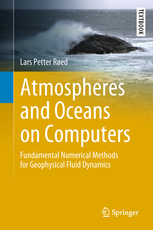Ancient Greek philosophers had a theory that everything was made up of four material elements: water, air, earth and fire. Much has changed since then. Air is now named atmosphere and water encompasses oceanography. These are the two central sciences for understanding of the relationship of weather, wind and climate. Great increase in computing power we see today has made the work of meteorologists, oceanographers, climate scientists and others much easier.

Research and teaching in the subject areas oceans and atmosphere are covered by the Section for Meteorology and Oceanography at the Department of Geosciences, UiO. Here, Professor Lars Petter Røed contributed for several decades to give Norwegian and foreign students the necessary competence to master programming and calculations in their future carreers.
The access to increasingly powerful computers provides many opportunities for anyone working in geosciences. For example, to calculate the movements in ocean and atmosphere, or fluid dynamics as the subject is known. In addition to being used in offshore and weather forecasting, such calculations are used in environmental monitoring, to analyse data and or to be used for risk and impact analyses.
From geophysical principles to basic numerical methods
The textbook “Atmospheres and Oceans on Computers” is published by Springer; it first appeared online in the autumn of 2018, and as a paper edition in 2019. The textbook ranges widely. It encompasses everything from fundamental geophysics to introducing step-by-step basic numerical methods needed to solve the equations that determine the motion of atmosphere and ocean.
How to develop instructions for a computer as part of a code, this book provides answers to that as well. Modern teaching requires a combination of theoretical and computational approaches in order to pick out the correct numerical method for the problem you want to solve.
For those interested, it is recommended to read the chapter "Front matter" available online. This outlines the contents of the textbook. It is also free for everybody, Røed says.
The way from teaching to a textbook
The textbook is based on Røed's teaching over several decades. From 2010 to 2016 in the subject GEF4510 - Atmosphere and Oceans on Computers: Fundamentals. Prior to this, the subject was taught separately in two subjects: Numerical models of the atmosphere (GEF4230) and Numerical solutions of oceanographic problems (GEF4620).
The foundation was laid in a compendium from the 1990s, and much is changed and added along the way. All the material and many of the examples and exercises have been tried tried out in the classroom. Røed became professor emeritus in 2016, so in the autumnof 2017, students were referred to the course Computational physics (FYS3150) taught by Professor Morten Hjort-Jensen. Through this, the latter became acquainted with Røed's compendium. The physics professor sent it to Springer, and the rest is history. After some audit work, the textbook is now available.
Students who have taken the course GEF4510 in the last 10-15 years will recognise much of the material. The book is based on the latest edition of the compendium for this topic, Røed confirm.
This is the first time that a scientist from UiO has published a textbook on meteorology and oceanography at an international publishing house. Røed states that he is constantly receiving inquiries from colleagues both from Norway and internationally about the book, and he hopes that it can be used as a textbook or as a reference book at higher education institutions that use calculations of geophysical flows.
By background, Røed is Dr. Philos in physical oceanography from the University of Oslo. Røed has also been a senior scientist at the Norwegian Meteorological Institute. He has been on longer stays in the US, besides working at the university of Bergen and Oslo, and Det Norske Veritas. Røed is currently Professor Emeritus at the Department of Geosciences.
Reference:
Røed, Lars Petter. 2018. Atmospheres and Oceans on Computers - Fundamental Numerical Methods for Geophysical Fluid Dynamics.Springer, pp 227 DOI: 10.1007/978-3-319-93864-6

